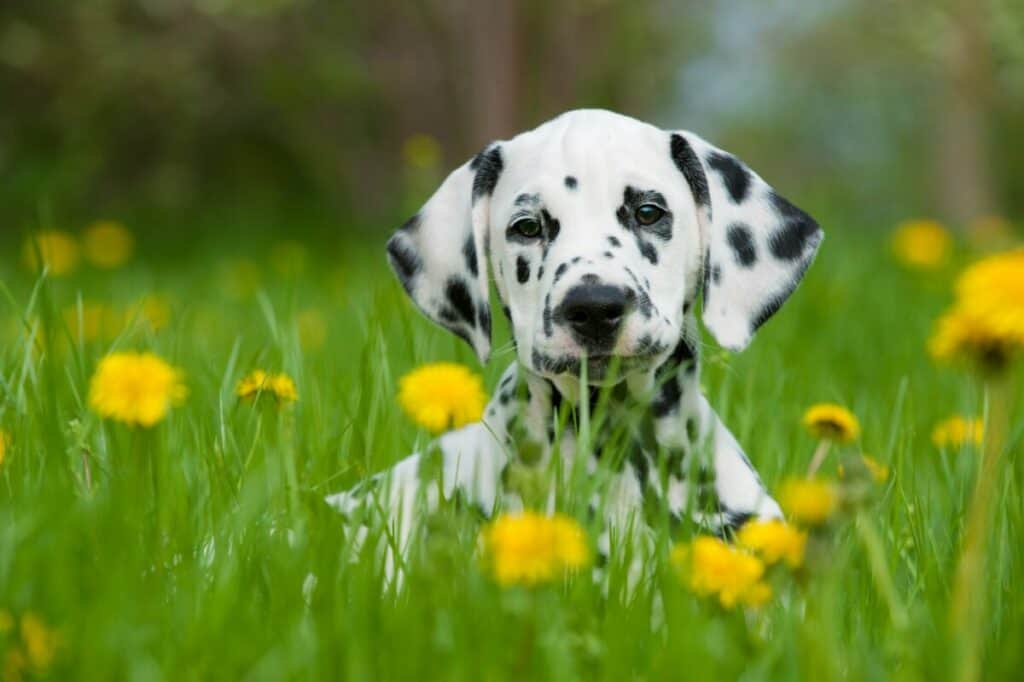
Dalmations are known for their black or brown spots, but many people are confused when their Dalmation puppies are born with completely white fur. So, do Dalmation puppies have spots?
Dalmatian puppies do not have spots until they are 10 days old. Dalmation puppies are born white and develop black spots on their white fur until they are 18 months old. While the spots can be black or a liver (brown) color, the rest of a dalmatian dog's coat is always white.
Dalmations are famous for their black and white spotted cloak that gives them their iconic, playful look. Dalmatians, however, are not born with their good looks, they have to grow into them. Going forward, we will talk about how, when, and why dalmatians get their spots.
At What Age Do Dalmatian Puppies Get Their Spots?
At birth, Dalmatian puppies have no spots in their fur. However, they might have spots that you can see on their skin through their plain white coats. Dalmatian puppies generally begin to develop their spots at just 10 days old and continue to develop more spots until they are pretty much fully grown at 18 months old.
The typical Dalmatian has a coat full of black spots on a white background. Dalmatians with liver brown spots are less common, as the liver color is a recessive gene, but is still accepted within the American Kennel Club's breed standards. However, this doesn't mean that Dalmations can only have brown or black spots.
How Do I Know if My Puppy is a Dalmatian?
Sometimes, dogs of other breeds also have spots and may appear similar to a Dalmatian puppy, so how do you tell the difference or know that your puppy truly is a dalmatian? To do that, we will need to talk about what makes a Dalmatian a Dalmatian.
We will go over some general standards as well as the American Kennel Club's standards. If your dog doesn't meet these, there's a chance it might not be a purebred Dalmatian.
Appearance
A full-grown Dalmatian is a large dog. Its height should be anywhere from 19-24 inches, and it should weigh no more than 70 pounds. Dalmatians have a square shape built for stamina and endurance. A Dalmatian has thin, medium-sized eyes that rest close to their head. Eye color isn't really a defining characteristic of a Dalmatian, as their eye color can range from brown to amber to blue.

Coat
A Dalmatian has a short and smooth coat. Generally, Dalmatians shed quite a bit, especially during the summer. Their coat doesn't require much upkeep, as occasional baths and weekly brushing will keep a dalmatians coat in great condition.
A shorter coat also means that Dalmatians won't carry too much of a wet or dirty dog smell with them and stay pretty clean, as dust or dirt can easily be brushed out.
According to the American Kennel Club, a Dalmatian should only have black or liver-colored spots, but just because your dog has different colored spots doesn't mean they are not a Dalmatian.
Depending on genetics, Dalmatian puppies can be born with back, liver, blue, brindle, orange, or lemon colored spots. Their noses can also be brown or black.
Dalmatians with black spots always have black noses and those with brown spots have brown noses, but for other-colored spots, there is no genetic standard.
An interesting fact about Dalmatian coats is that no two are the same, they all have a different configuration of spots.
Temperament
Although dalmatians can be pretty protective and watchful by nature, they are generally fairly open to strangers as long as their owner is comfortable as well.
Dalmatians are very social and love their owners fiercely along with being eager to please. These dogs are no couch potatoes and need frequent stimulation and exercise in order to stay happy and healthy. Dalmatians can be good family dogs and interact well with children and other dogs but may need to be introduced to new people slowly and on their own terms.
Foolproof Ways to Know if Your Puppy is a Dalmation
Although you may be able to tell if your puppy is a Dalmatian by its appearance and temperament, there are two foolproof ways to make sure that your puppy truly is a Dalmatian. The First would be buying a puppy from a reputable breeder, and the second would be through genetic testing.
A reputable breeder will have papers authenticating that not only both the parents are purebred Dalmatians but healthy dogs that will not pass on any genetic health defects to your puppy. You can find reputable breeders through the American Kennel Club or through your own vetting process.
Since most reputable breeders provide genetic testing of the parents to owners of their puppies, a test won't be necessary. However, if you didn't meet the breeder or receive the paperwork, you can order and send in a genetic testing kit to confirm your dog's identity as a Dalmatian.
Why Do Dalmatians have Spots?

There are a few theories out there about why dalmatians have spots. One theory is that the spots served as some kind of camouflage when these dogs lived in the wild. Another theory that is more widely selected is that instead of natural selection, the spotted pattern is a result of selective breeding.
This selective breeding entails that humans were carefully selected and bred to promote this ‘spotted' gene. Dalmatians are an ancient breed, and no one really knows where they came from, but we have evidence that Dalmatians existed as early as the 16th century.
The theory of the spots serving as a kind of camouflage doesn't hold up well simply because of the variety of work that Dalmatians have done. The breed has served as sentinels as well as herding, ratting, and hunting dogs. However, they are best known for their work as coach dogs.
Coach dogs would run in front of and alongside stagecoaches, mainly fire coaches, to clear the crowd and allow the stagecoach to pass. Although they are no longer bred for or used as coach dogs, this is why the Dalmatian has become a symbol or mascot for firehouses and their men.

Cindy is a prolific writer and online researcher who can't imagine life without dogs. There is scarcely a dog topic she has not researched or written about. Her love for dogs and helping dog parents is evident by the thousands of dogtemperament.com visitors who read her articles monthly. Most of all, each topic Cindy writes on helps forge a stronger bond and understanding between her and her happy Catahoula Leopard Dog Jossie.